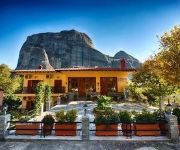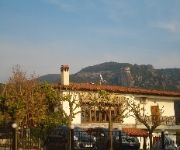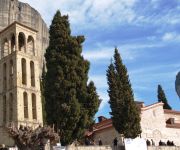Facts and Data
Webpages:
Official Unesco Page
View photos from OUR PLACE the World Heritage collection
Hellenic Ministry of Culture
Protectedplanet.net
Basis Data:
Unesco World heritage since: 1988
Size of heritage: 272 ha
- Buffer zone: 1,884 ha
Coordinates:
Longitude: 21,633°
Latitude: 39,717°
Summary
In a region of almost inaccessible sandstone peaks, monks settled on these 'columns of the sky' from the 11th century onwards. Twenty-four of these monasteries were built, despite incredible difficulties, at the time of the great revival of the eremetic ideal in the 15th century. Their 16th-century frescoes mark a key stage in the development of post-Byzantine painting.
Location on Map
Show bigger map on Openstreetmap
Introduction
Meteora is a UNESCO World Heritage site located in the Prefecture of Trikala, in the Thessaly region of Greece. It is renowned for its breathtaking rock formations, perched high above the ground, and its historic monasteries that seem to defy gravity. The name "Meteora" translates to "suspended in the air," which perfectly captures the essence of this unique site.
History
The history of Meteora dates back to the 9th century when the first hermits settled in the area seeking solitude and spiritual enlightenment. These hermits lived in natural caves and fissures within the rocks. Over time, the number of hermits increased, and they began to build rudimentary shelters and small chapels.
During the 14th century, the monastic community of Meteora started to take shape. The monasteries were constructed on top of the towering rock pillars, providing a safe haven for the monks from invading armies and political turmoil. The construction of the monasteries was a remarkable feat, as building materials and supplies had to be hauled up the cliffs using ropes, ladders, and baskets.
By the 16th century, there were 24 monasteries in operation, each with its own unique architectural style and artistic treasures. However, over the centuries, many of the monasteries fell into decline due to wars, natural disasters, and the difficulty of maintaining such remote structures.
Current State
Today, Meteora is home to six functioning monasteries, which have been carefully restored and preserved. These monasteries are open to the public, offering a glimpse into the spiritual and cultural heritage of the region.
The monasteries of Meteora are not only architectural marvels but also house a wealth of religious artifacts, manuscripts, and Byzantine frescoes. Visitors can explore the monastic complexes, admire the stunning views from the cliffside balconies, and learn about the monastic way of life.
Access to the monasteries is possible through a network of staircases carved into the rocks or by using a system of pulleys and nets. This adds to the sense of adventure and awe that visitors experience when visiting Meteora.
In addition to the monasteries, the natural beauty of Meteora is a major draw for tourists. The towering rock formations, with their unique shapes and colors, create a surreal landscape that is unlike anything else in the world. Hiking trails and viewpoints allow visitors to fully appreciate the grandeur of the site.
Meteora has become a popular destination for photographers, nature enthusiasts, and those seeking a spiritual retreat. Its inclusion on the UNESCO World Heritage list has helped to raise awareness about the importance of preserving this cultural and natural treasure for future generations.
Conclusion
Meteora is a testament to human ingenuity and the power of nature. Its monasteries perched atop towering rock pillars and its awe-inspiring landscape make it a truly unique and captivating destination. The preservation and restoration efforts have ensured that this UNESCO World Heritage site continues to inspire and amaze visitors from around the world.
Hotels and places to stay
Divani Meteora
Mythos Guesthouse
Elena Guesthouse
Archontiko Mesohori
Thalia Rooms Guest House
Guesthouse Papastathis
Alexiou Hotel
Papastathi
King Lodge
Orfeas
Videos from the area
Videos provided by Youtube are under the copyright of their owners.

















